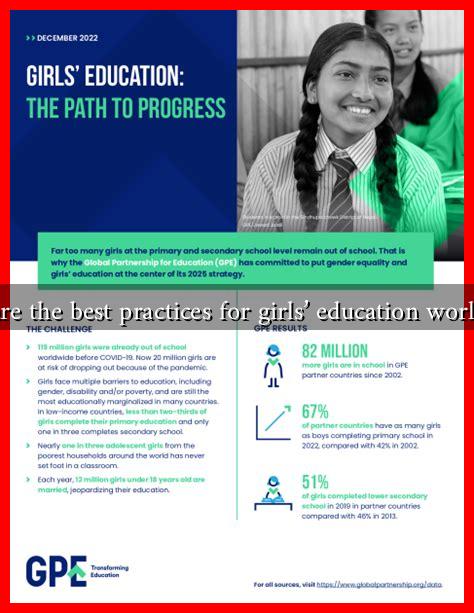-
Table of Contents
- What are the Best Practices for Girls’ Education Worldwide?
- Understanding the Barriers to Girls’ Education
- Best Practices for Promoting Girls’ Education
- 1. Community Engagement and Awareness
- 2. Financial Incentives
- 3. Safe and Inclusive Learning Environments
- 4. Empowering Girls through Leadership Programs
- 5. Leveraging Technology
- Case Studies of Successful Initiatives
- Conclusion
What are the Best Practices for Girls’ Education Worldwide?
Education is a fundamental human right and a powerful tool for social change. However, girls around the world still face significant barriers to accessing quality education. According to UNESCO, over 130 million girls are out of school globally. This article explores best practices for promoting girls’ education, highlighting successful strategies and initiatives that have made a difference.
Understanding the Barriers to Girls’ Education
Before discussing best practices, it is essential to understand the barriers that hinder girls’ education. These barriers can be categorized into several key areas:
- Cultural Norms: In many societies, traditional beliefs prioritize boys’ education over girls’.
- Economic Factors: Families may struggle to afford school fees, uniforms, and supplies, leading them to prioritize boys’ education.
- Safety Concerns: Girls often face violence and harassment on their way to and from school, deterring them from attending.
- Lack of Facilities: Inadequate sanitation facilities, especially for menstruating girls, can prevent school attendance.
Best Practices for Promoting Girls’ Education
To combat these barriers, various best practices have emerged globally. Here are some of the most effective strategies:
1. Community Engagement and Awareness
Engaging communities is crucial for changing perceptions about girls’ education. Programs that involve parents, local leaders, and community members can foster a supportive environment for girls. For example, the Girls Not Brides initiative works with communities to raise awareness about the importance of girls’ education and the negative impacts of child marriage.
2. Financial Incentives
Providing financial support can significantly increase girls’ enrollment and retention rates. Conditional cash transfer programs, such as those implemented in countries like Mexico and Brazil, offer families financial incentives to keep their daughters in school. A study by the World Bank found that these programs can increase girls’ school attendance by up to 30%.
3. Safe and Inclusive Learning Environments
Creating safe and inclusive schools is vital for encouraging girls to attend. This includes:
- Implementing anti-bullying policies.
- Providing gender-sensitive training for teachers.
- Ensuring access to proper sanitation facilities.
For instance, the UNICEF has launched initiatives to improve school infrastructure, making schools more welcoming for girls.
4. Empowering Girls through Leadership Programs
Leadership programs that empower girls to take charge of their education and advocate for their rights can have a profound impact. Organizations like Girls Leadership provide training that helps girls develop confidence and leadership skills, enabling them to become advocates for their education and communities.
5. Leveraging Technology
Technology can play a transformative role in girls’ education. Online learning platforms and mobile applications can provide access to educational resources, especially in remote areas. For example, the Khan Academy offers free online courses that can be accessed by girls who may not have access to traditional schooling.
Case Studies of Successful Initiatives
Several countries have successfully implemented these best practices, leading to significant improvements in girls’ education:
- Rwanda: Post-genocide, Rwanda focused on gender parity in education, achieving near-equal enrollment rates for boys and girls by implementing policies that promote girls’ education.
- Bangladesh: The Female Secondary School Stipend Program has increased girls’ enrollment in secondary schools by providing financial incentives to families.
- Malawi: The introduction of girl-friendly schools has led to increased attendance and retention rates among girls, particularly in rural areas.
Conclusion
Investing in girls’ education is not just a moral imperative; it is essential for sustainable development. By understanding the barriers girls face and implementing best practices such as community engagement, financial incentives, safe learning environments, empowerment programs, and leveraging technology, we can create a world where every girl has the opportunity to learn and thrive. As we move forward, it is crucial for governments, NGOs, and communities to collaborate and prioritize girls’ education, ensuring that no girl is left behind.

